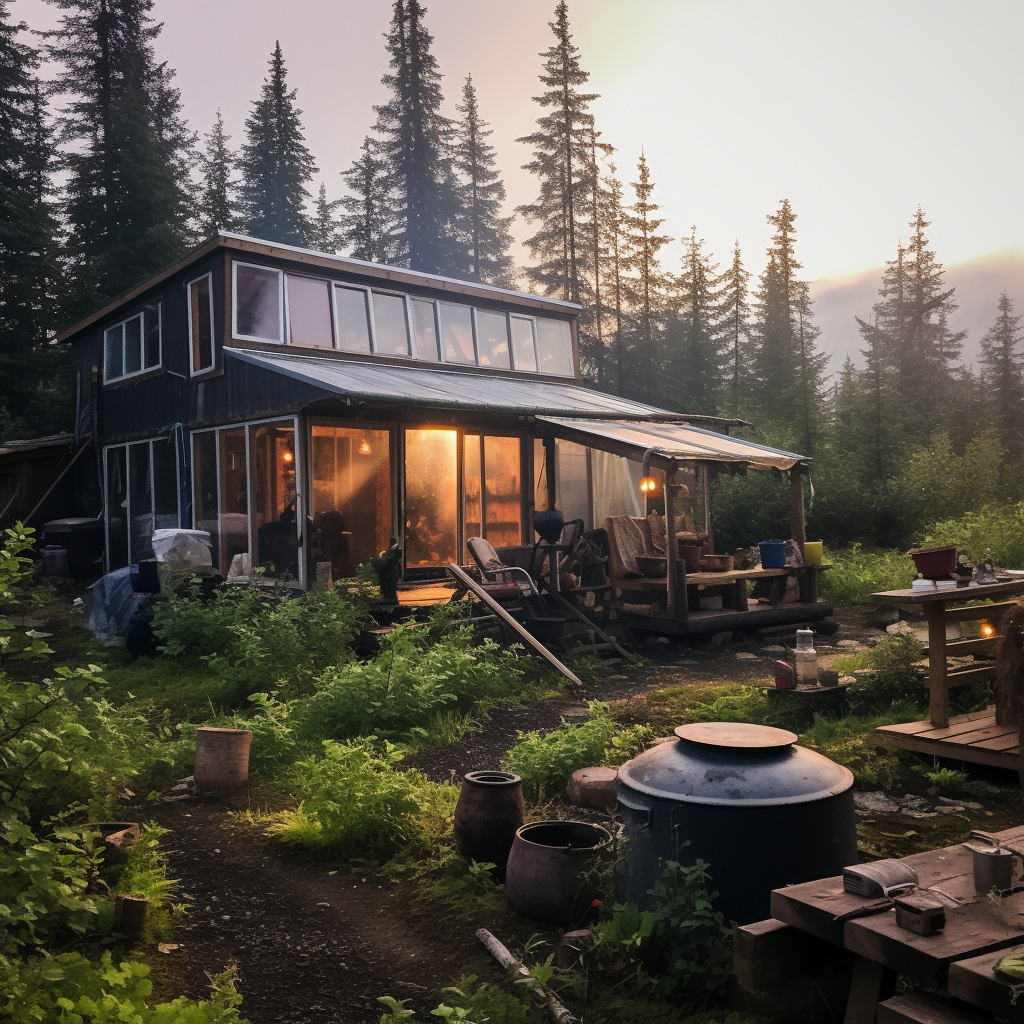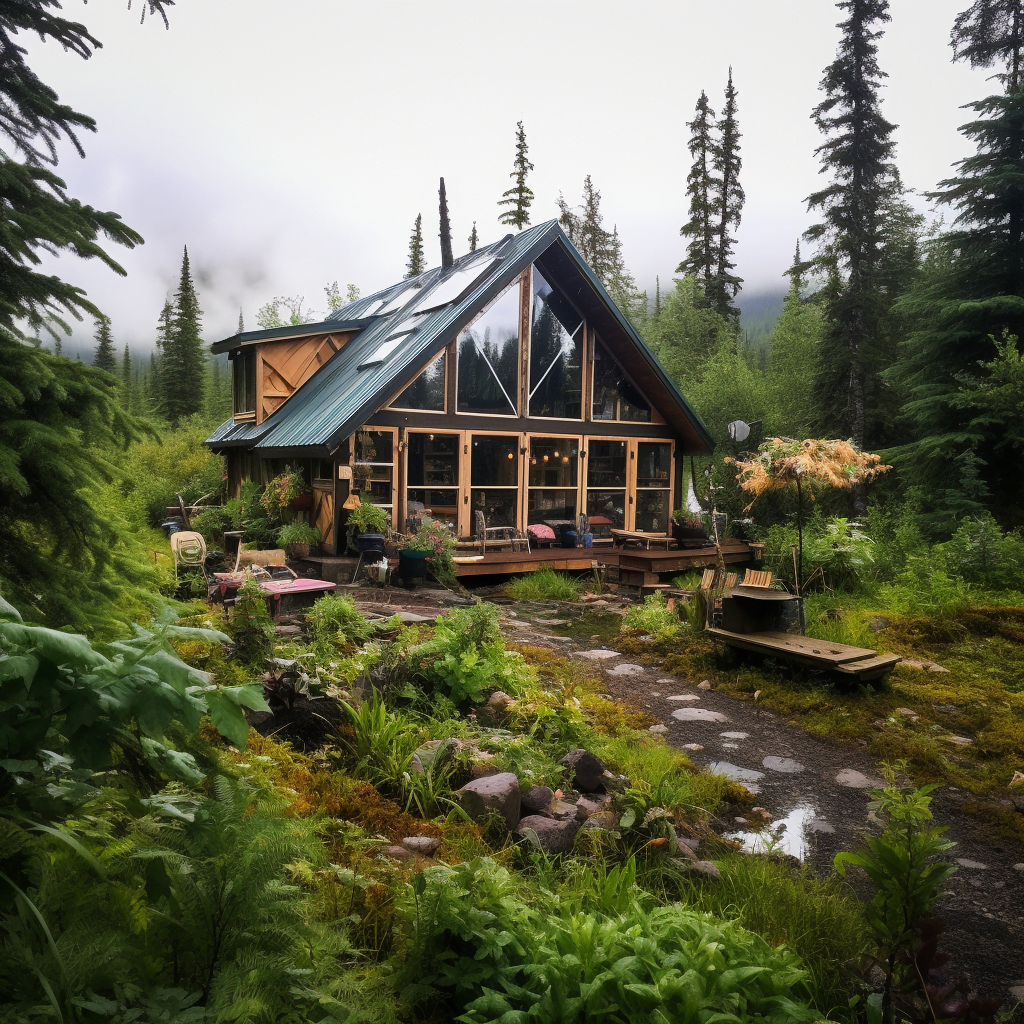Living off the grid in Alaska allows for ultimate freedom, self-sufficiency, and connection with nature. However, thriving in Alaska’s harsh climate and remote locations takes thorough preparation and learned skills. This comprehensive guide covers everything you need to know to successfully disconnect from society’s infrastructure and go off the grid in the Last Frontier. So stay tuned for the long story on How to Go Off Grid in Alaska!
Choosing the Ideal Remote Location
Selecting the right location is crucial when planning an off-the-grid homestead in Alaska. Key factors to consider include:
Climate Conditions – Alaska spans multiple climate zones from icy Arctic to temperate rainforest. Consider average temperatures, typical snowfall, winter duration, and extremes in the area. Some regions see -60F or colder in winter, while others have more moderate weather.
Proximity to Water – Living near a fresh water source provides drinking water, ice for refrigeration, ability to bathe, fish, and travel by boat. Situate near a river, lake, stream, or glacier runoff if possible. Collecting and melting snow can also supply emergency water.
Distance from Towns – While remoteness is part of the appeal, consider how far you are from the nearest town or city. Occasional supply and gear runs will be necessary, as well as access to medical facilities in an emergency.
Natural Shelter – Areas with existing wind blocks and shelters like dense forests, caves, rocky outcroppings have advantages. Building amongst trees offers insulation and reduces winds.
Wildlife – Certain areas have higher bear populations or other dangerous wildlife. Research wildlife in the area and prepare accordingly.
Soil Quality – Some regions have better soil for gardening and agriculture than others if you plan to grow crops.
Population Density – Remote undeveloped areas offer solitude but come with risks. Being within reasonable range of a small town or homesteading community can provide security.
According to Alaska natives and seasoned homesteaders, ideal off-grid locations offer:
- Abundant natural resources and food sources
- Low population density
- Limited government oversight and regulation
- Rugged terrain encouraging self-reliance
- Connection to nature and wild beauty
| Location | Description |
|---|---|
| Southwest Coastal | Milder weather, shoreline access, fishing |
| Interior Highlands | Harsh winters but good hunting and foraging |
| Brooks Mountain Range | Extreme isolation and conditions |
| Matanuska-Susitna Valley | Closer to civilization but scenic |
| Inside Passage | Island living, wildlife and ocean access |
Visit potential spots in person before committing. Spend time familiarizing yourself with the land, climate, native plants and animals before establishing an off-grid presence.
Constructing a Self-Sufficient Shelter
Having solid, well-insulated shelter is critical for surviving in Alaska’s extreme weather conditions. Some possible housing options include:
Log Cabin – The classic remote Alaskan shelter. Handcraft your own from local timber or buy a pre-cut cabin kit. Choose an efficient floorplan.
Yurt – Circular tent-like structures based on ancient Mongolian housing. Well-insulated for year-round livability. Portable.
Tipi – Sturdy, tall cone tents popular with North American tribes. Portable and good at shedding snow.
School Bus – Repurposed school buses make budget-friendly small homes. Insulate well.
Natural Shelters – With skill, caves or rock overhangs can be adapted into shelters.
When constructing an off-grid homestead, consider:
Sustainable Materials – Use local, responsibly sourced materials. Avoid excessive tree clearing. Reuse and repurpose where possible.
Structural Design – Choose shapes and buildings techniques suitable for wind, snow loads, and ground conditions in your area. Reinforce against storms.
Insulation – Heavily insulate walls, roof, foundation and around doors and windows to conserve heat. Use thick walls and layers.
Windows – Install double paned windows. Angle to maximize solar gain in winter, avoid overheating in summer. Include insulated shutters/storm windows.
Heating – Wood stoves, passive solar, contained fires provide heat without electricity. Install proper ventilation and chimneys.
Water Collection – Set up rain catchment systems, hand pumps, transportation methods to gather water.
Waste Systems – Composting toilets, greywater systems, trenches, outhouses safely handle waste.
Custom Touches – Add personality like carved doors, recycled décor, and energy saving adaptations.
With ingenuity, appropriate tools, and hard work you can construct a sturdy shelter optimized for thriving off-grid even in Alaska’s harsh conditions.

Securing Reliable Food and Water
Sourcing adequate food and water year-round takes forethought and effort in Alaska’s remote regions. Some strategies include:
Hunting/Fishing
- Bow hunt moose, caribou and bear during appropriate seasons. Learn field dressing.
- Snare small game like hares, grouse, ptarmigans.
- Ice fish for salmon, trout, grayling through holes in frozen rivers and lakes.
- Always use ethical, sustainable practices to preserve resources.
Foraging
- Pick ripe high-bush blueberries, crowberries, salmonberries, currants in summer/fall.
- Harvest wild chives, mustard greens, stinging nettle, chaga mushrooms. Dry or pickle.
- Take foraging courses to safely identify edible plants.
Growing Food
- Build small greenhouse structures and cold frames to extend the short growing season.
- Grow hardy crops like kale, beets, carrots, potatoes, onions, herbs.
- Start seedlings early indoors and transplant after last frost.
- Use composting, mulches and organic methods to enrich poor soils.
- Learn techniques like succession planting to maximize harvests.
Hunting/Fishing/Foraging Permits – Research and comply with all state regulations around subsistence harvesting, bag limits, and seasons.
Water Access
- Draw fresh water from lakes, streams, collecting rain. Boil or filter for contaminants.
- Melt clean glacial runoff water for use.
- Drill well if groundwater available. Hand pump or use solar power.
Preservation/Storage
- Store several months of non-perishable food supplies before winter.
- Smoke, salt, pickle, can, or freeze fish, meat, and produce to preserve.
- Cache food in bear-proof containers away from shelter to prevent wildlife run-ins.
Mastering old-school food gathering, preparation, and preservation methods allows you to thrive from the land.
Harnessing Renewable Energy
Generating your own power is essential when living off-grid in Alaska. Options include:
Solar – Thanks to Alaska’s long summer days where the sun barely sets, solar works well. Use solar photovoltaic (PV) panels and battery banks to store power. Size your system to handle seasonal fluctuations.
Micro-Hydro – Harness the power of flowing water. Divert a stream through a turbine or waterwheel to generate continuous electricity.
Wind – Alaska’s gusty conditions are ideal for wind turbines. Choose appropriate size and tower height to match location. Connect to batteries.
Wood – Use wood you harvest sustainably as fuel for heating and cooking. Install high efficiency wood stoves, boilers, and fireplaces.
Geothermal – If you have hot springs nearby, use the geothermal heat for a radiant heating system.
Determine energy needs based on shelter size, appliances, tools you require. Invest in high-quality equipment designed for rugged Alaskan use. Maintain and protect systems from snow, ice, and curious wildlife. Combining sources provides reliable off-grid power year-round.
Handling Logistics and Lifestyle Considerations
In addition to basic needs, going off-grid in Alaska requires adaption in many areas:
Supplies/Repairs – Stock up on double the supplies and equipment you expect to use right before winter. Be prepared to make repairs with what you have on hand.
Travel – Snow machines, snowshoes, dogsleds, boats with motors allow you to traverse remote terrain. Maintain trails.
Communications – Invest in emergency radios, satellite phones since cell service is non-existent. Learn emergency protocols.
Health – Keep first aid supplies on hand. Know basic medical care. Establish care plan for serious illness/injuries.
Community – Join off-grid networking groups to share knowledge. Barter and trade with nearby homesteaders.
Security – Install fences around property, bear-proof food storage, and weapons for protection. Beware of strangers.
Schooling – Homeschool kids yourself or interact with other families online/radio. Teach practical skills.
Mental Health – Cope with isolation and cabin fever during long winters. Bring enough entertainment and projects to occupy time when you cannot venture outside.
Finances – Going off grid requires significant upfront investment. Save money ahead of time and be frugal. Hunting/fishing reduces food costs. Be ready to pay high prices for any supplies brought in from towns.
Skills – Take courses in homesteading, survival training, outdoorsmanship to learn all the necessary skills from experienced people before striking out on your own. Continuously build your knowledge.
Laws – Be aware of land use laws, especially on public lands. Claim remote parcels legally. Seek proper permits for hunting, building, fires, etc.
Sustainability – Live lightly on the land. Minimize waste, reuse materials, and use resources extremely responsibly. Leave minimal traces of your presence.
Adaptability – Be flexible and ready to problem solve. Use innovative solutions when issues arise in the wilds. Improvise fixes with limited tools and supplies.
While challenging, going off the grid in rugged Alaska offers rewarding payoffs for those seeking self-reliance and connection to nature. With vision, grit, adaptability and competent skills, you can successfully disconnect from society and carve out an independent homesteading life amidst Alaska’s wild beauty. Immerse yourself in age-old living techniques, sustainable practices, and the rich wisdom of native cultures. Forge bonds in small frontier communities. Live simply, deliberately, and gain profound perspective on what truly matters. Experience the extremes of the northern wilds, from endless summer days to winter darkness, with newfound awe and humility. Alaska’s unique landscapes hold timeless, liberating lessons for those bold enough to answer the call of the wild.




